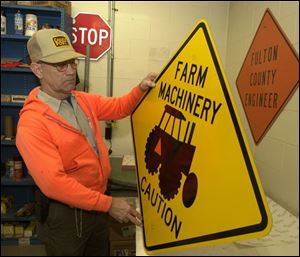
Wider farm machines may pose greater peril
4/9/2001
Bill Eddings, with one of Fulton County's warning signs that will keep him busy this week, will be replacing signs warning motorists of ice with ones warning of farm machinery.
OTTOKEE, Ohio - Bill Eddings has his assignment for this early-spring week: Put up “Watch For Farm Machinery'' signs on Fulton County overpasses.
Mr. Eddings will load up his truck at the county garage and cover the area one day this week. He'll replace “Watch Out For Ice On Overpass'' signs with the farm machinery warning.
It's none too soon.
Already, northwest Ohio farmers are pulling onto roads with big tractors and bigger implements. And that can spell danger for motorists who don't pay attention to the ever-present chance of coming upon or overtaking farm machinery that is wider than one lane.
There have been accidents, some tragic, when cars traveling at normal speeds have met very slow-moving farm tractors pulling large implements that take up most of a road.
In October Ohio Highway Patrol trooper Brenda Pahl of Defiance lost a hand when her car struck an oncoming farm implement in Wood County. The car hit an 18-foot-wide disc pulled by a tractor. When an airbag pushed her arms outward, a disc blade sliced her arm off. It was successfully reattached at Medical College of Ohio Hospital.
After farmer Jerry Matheny was killed when a tractor-trailer rig hit his tractor in 1991, his widow, Linda Matheny, mounted a successful campaign that led to Wood County erecting county-road signs reading: “This is Farm Country. Watch For Slow Moving Farm Machinery on Roadway.''
In Fulton County, warning signs go up on the riskiest places: the crests of overpasses where cars can suddenly come face-to-face with a wide, tractor-hauled farm implement.
Spot checks showed that Lucas County and Defiance County do not put signs warning of farm machinery on any roads.
In Michigan, Hillsdale County does not install warning signs but has a few at locations if requested. But they have to be paid for by farmers, said Stanley Clingerman, county engineer-manager.
“We're a rural county, and people here understand that there could be farm vehicles on any road at any time,'' he said.
Fulton County has replaced the “ice'' signs with the farm machinery alerts for 20 years, said Bob Lovejoy, county highway supervisor.
Mr. Eddings will put up 18 such signs, two on each of nine county roads that cross the Ohio Turnpike.
“We put some other warning signs at certain blind curves, but we can only put them on county roads,'' Mr. Lovejoy said.
The Ohio Department of Transportation is the only agency that could put farm machinery warnings on state routes, but it does not have such a policy, said Joe Rutherford, spokesman for the agency's District 2 office in Bowling Green.
“But any time large machinery is on the road, a motorist should obey traffic laws and give tractors plenty of respect and clearance. They're bigger,” he said.
It is most often the farmer on the tractor who is injured in a collision from behind or a clip from a passing car on the side.
In 1999, the last year for which statistics are complete, there were 232 farm vehicles and 121 pieces of farm equipment involved in traffic accidents in Ohio, according to ODOT's Department of Public Safety.
Those accidents resulted in nine deaths and 82 injuries.
The question of warning signs on state highways has been debated. Most counties do not install signs, nor does the state, although years ago Ohio did install signs featuring the silhouette of a man on a tractor and the words “Watch Out For Farm Machinery.”
The state has approached farm vehicle road safety with a state law that requires tractors to have amber flashing lights on both sides, two red reflectors on the rear, and two amber reflectors on the front.
Lights must be displayed between sunset and sunrise and whenever a day becomes darker than usual.
“Something should be done because of the size of much wider farm equipment nowadays. It gets wider and wider,'' said Jim Schortgen of the ODOT office in Wauseon.
Warning signs on overpasses are especially necessary, Mr. Lovejoy said.
“Drivers go up in a car, they can't see an oncoming vehicle until they get on top,'' he said. “If a farmer on a tractor, pulling a combine is there, taking almost the whole road, and the driver isn't alert, they're going to hit.
“Even with signs, we encourage farmers to send somebody ahead to warn cars.''
The Ohio Farm Bureau would like to see overpass warning signs approved for use on state highways, said Roy Norman, a spokesman with the group's Pettisville office.
Signs could help on open roads, too, Mr. Norman said.
“Most accidents seem to be rear-enders or sideswipes. Motorists going 60 or 65 mph come up on equipment going 25 mph and drivers don't realize how fast they catch up. They don't have time to react,'' he said.
The Farm Bureau has been active in getting “Slow Moving Vehicle “signs on farm equipment, as required by state law.
Educational promotions urge drivers to slow down well before getting near farm machinery and always give tractor drivers time to turn or move over.